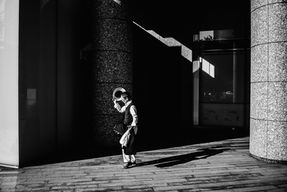
ms optics 28mm f/2.0 apoqualia-G II Review
updated 2025/04/18
A few months back, the small bug bit me again. I don't know if it was all the X100's I'd been seeing around, but I was very aware of how much of a (beautiful) tank my Voigtlander 40 1.4 setup is. I wanted something small, light, yet somehow also with a big aperture. That gave me...not many options.
I eventually stumbled on the MS Optics 24 4.0 and honestly couldn't believe what I was looking at. From there I found their 28mm 2.0 which was so in line with what I had been looking for I almost felt I'd dreamed it into existence. These lenses are, to my knowledge, designed and hand-assembled in Tokyo, by a single genius by the name of Miyazaki.
I deliberated over the purchase while painstakingly looking up and reading everything about it online, but user impressions and reviews were few, as were real world image samples, so my eventual decision to buy it was a bit of a leap of faith. Lens in hand, it's solid, metal, smooth, and tiny. A wonder of a lens.

The Apoqualia pairs perfectly on a Sony A7S. I use a cheap 1000¥ adapter that is honestly the best I've used after trying a range of medium-tier ones. It's all black and fits solidly. This setup is completely out of the way, light and freeing. The Apoqualia weighs in at a lean 70 grams, so it's not tiring to carry and hold to your eye at all. You could almost forget a lens is there, were it not for how much time you spend checking it's at the right aperture and focal point.
I have two slight annoyances with the handling of this lens: the clickless aperture and the focus throw. I prefer clicked apertures because it's reassuring and more efficient. I don't shoot video, so there's no benefit for me. The focus throw is convenient in that you can get from max to minimum focal distance with something like a 150° rotation. However, the distance from infinity to 5m and so on is so short that just the slightest nudge sets you in a different ballpark. And I'm not superstitious, but I swear it moves on it's own sometimes.

Focusing closer, once you get to .8m, the throw grows significantly larger. This brings me to a pleasant surprise about this lens - it can focus all the way down to .4 meters. Should you care to throw on a helicoid close-focusing adapter, you'll be able to get ridiculously close to your subject.
The lens is well dampened. I adjust the aperture by rotating the 28mm lens filter (pictured) I threw on it. The lens comes with a petite metal lens hood, but it leaves the front element a bit too exposed for my liking, obscures the aperture indicator, and due to it's shape, tends to get caught on things. If you do go naked, you'll have to manipulate the aperture using two tiny notches near the front element, which is wholly impractical.

For focusing, the lens comes with a "nubbin", a tiny screwed-in metal tab or knob that is very prone to flights of fancy unless you secure it better with some clear nail polish as I did. I generally prefer tabs over plain focus rings and this nubbin is no exception - it's a joy to use.
I still can't believe this tiny thing opens up all the way to f2.0. Yes, there are compromises to get there, but that it's even an option is incredible to me. Results at f2 can range from stunning to somewhat disappointing. Place the subject at a relatively close distance and in the center of the frame, and you're bound to love the results. If the subject is near the corners though, expect smearing.
Shooting at the largest aperture, things continue to get even more interesting, or perhaps bizarre, as you learn that the edges of the frame are more-or-less in focus regardless of where you're focusing. It's a fascinating but occasionally disorienting effect. This lens is quirky, no doubt. If you want character, you'll find it here.

At f2, there's significant vignetting. A typical 28mm filter will exaggerate it a bit more, but stop down to say f8 and it largely clears up. The way the lens deals with coma can be a bit of an issue. Shooting at night with environmental lights in the frame can give you some interesting results, but it can be excessive at times, even for me. You should also be prepared for (or look forward to) some flare.
I like the bokeh.

I've had it for a few months now, and the MS Optics 28 2.0 Apoqualia-G II has definitely become a favorite of mine. I'm not likely to use it for work beyond perhaps some portraiture, but I didn't buy it with that intention. It's now my default street lens on account of how easy it is to take everywhere. It's attractive, charming in it's diminutiveness, unusual, challenging, and importantly, fun to use. 28mm is a well-established focal length for street photography, and I enjoy the perspective. It sits comfortably between my 40mm and 21mm.
This is my first review, possibly of anything ever, and I'm starting with this lens because of how sparse user impressions and photographs made with it are. Maybe this'll be of some use to anyone on the fence, like I was. If you just happen to enjoy reading about user experiences with lenses, I hope you like what you found here.
For more photographs taken with the Apoqualia, have a look at my instagram, which features images predominately made with this lens.

UPDATE 2020/11/02: It seems this is getting some views, so I thought I'd provide an update for those interested.
I recently discovered that my copy's focus throw is off by a significant amount. I don't know if it was there from the start or if it somehow developed this issue over time. I always thought that whatever lack of sharpness I was getting was due to early onset lens diffraction and/or user error. It's currently out for repair with Miyazaki-san via Japan Camera Hunter, who was quick to respond to my issues.
At the end of the day, I still very much like the images I've produced with it up till now and we'll see if I can do better with it once I get it back.
Since buying the Apoqualia, the vast majority of my street photography has been taken with it. Everything I wrote in my original review pretty much still stands. Whether you appreciate its results or not, it can't be argued that its not a unique lens. It's the flattest and widest pancake I've ever used.
I've also had a number of emails about which filter I use. I use a Hoya 28mm/0.75 UV[N] HMC filter.
UPDATE 2025/04/18: Has it really been almost 5 years?! (I've been using this lens for almos t7
I recently redesigned my website, so I thought I'd take the opportunity to update this review. I've left the original content as is.
I still use this lens a lot (now on a Leica SL2-S) and despite saying I didn't buy it for the purposes of work, I do now shoot certain assignments and portrait shoots with it from time to time. I post a lot of photos taken with it on my Instagram account. You can probably tell which photos are taken by it solely by the character and field of view.
The focus throw is still off by a significant amount, despite having been recalibrated by Miyasaki-san. It is a significant impediment to range focusing, especially wide-open. The 1.2 meter mark is actually something like .8m and infinity is reached at about 3m. Dust has also been accumulating inside. I failed to mention in my previous update that it had also developed rust and so I'd sent it to get cleaned along with the recalibration. I'm happy to say the rust has not returned.
I lost the "nubbin" on a trip to Hokkaido and had to order another one (not cheap). I superglued the new one in. I also lost my lens filter in Ginza somewhere and bought a generic new one off Ebay. (If you're thinking "man, this guy is super careless" - I just shoot with this lens a lot and these are all small parts prone to unscrewing, detaching, and vanishing.) Optically, I can't tell the difference. I still want my original as it shows its experience -- there's a huge dent in it -- so if you happen to find it, let me know.
Lastly, I do sometimes wish I'd sprung for the black urushi version. Sometimes.
See you in 5 years or so, maybe. Cheers.




























